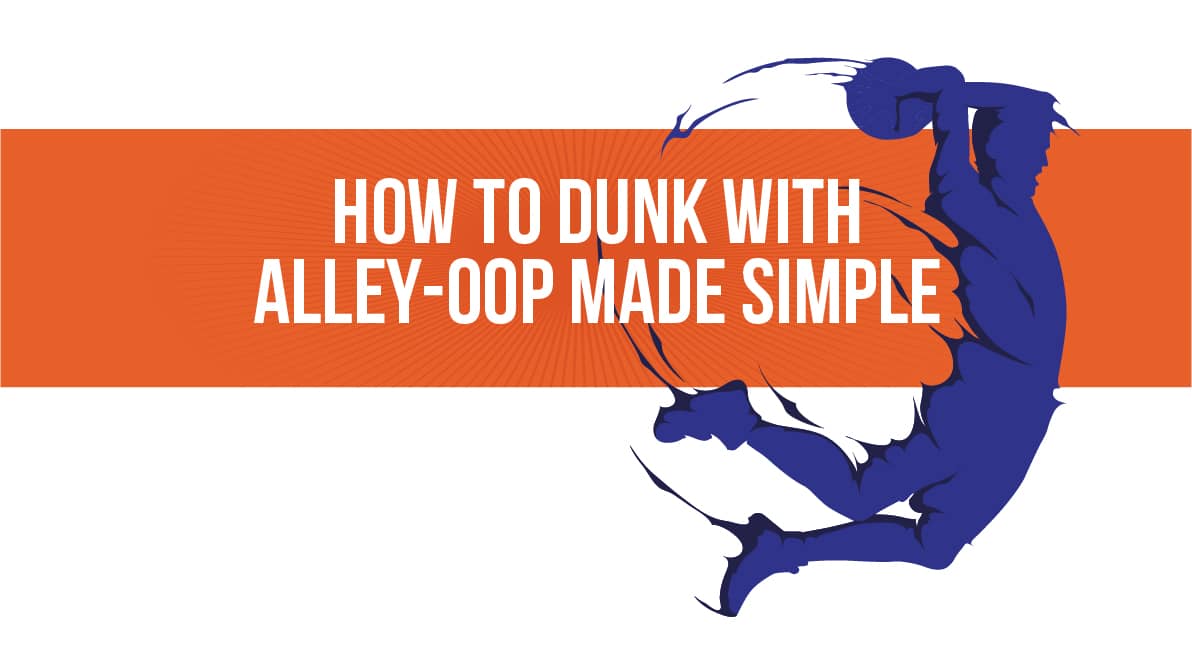
For those who are unfamiliar with the term, the first clue to an Alley-Oop Dunk lies in the name itself. The term Alley-Oop is actually borrowed from French circus performers who typically use the cry of “allez hop!” during an acrobatic circus act. It literally means “Over You Go”.
In the great American tradition of taking a foreign word and changing the spelling to suit the country’s domestic needs, the basketball fraternity now finds itself confronted by the Alley-Oop Dunk instead.
Disregard for spelling aside, American sports has at least maintained the core traditions of the Alley-Oop - although sources reveal that it was in fact the NFL community that first popularized the term. The Alley-Oop has since gone on to become one of the most glamorous plays executed on the basketball court.
The Alley-Oop Dunk - in all its incarnations - has also become a prominent feature in the NBA’s Slam Dunk Contest. Every player wants to execute it and every spectator wants to see it executed. It was once said that if you give the people what they want, they will love you for it!
How Do You Dunk With Alley-Oop?
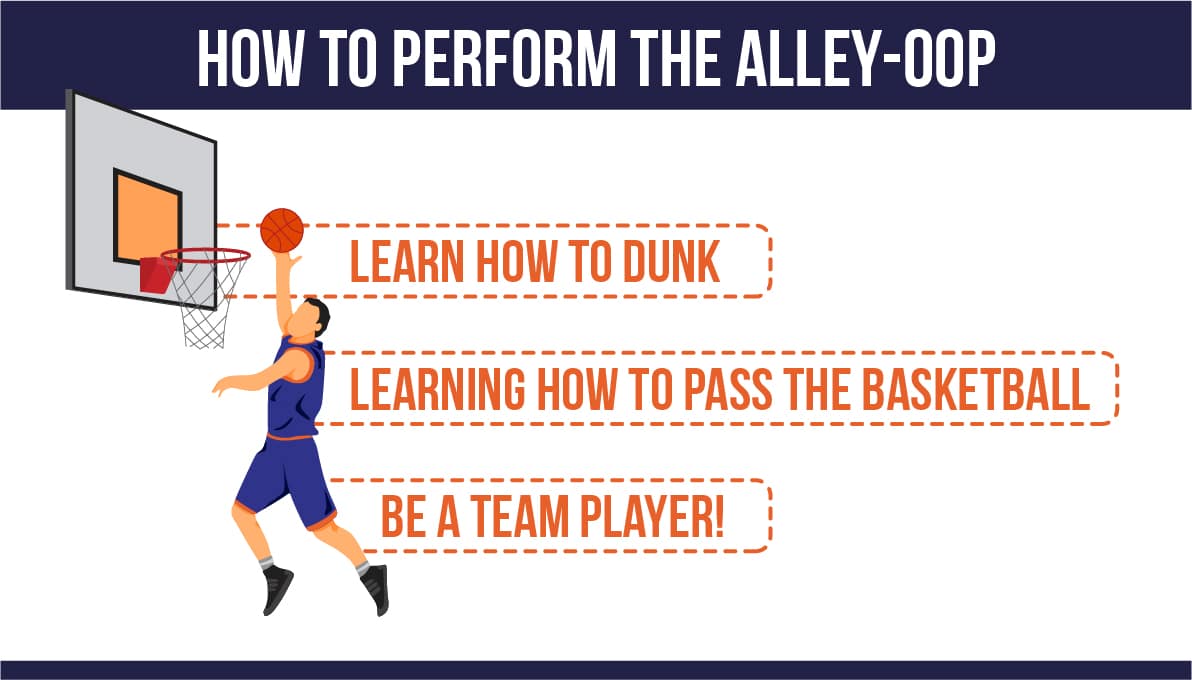
If you harbour any aspirations of completing the Alley-Oop Dunk with considerable aplomb, there are three elements to your game that ought to be thoroughly developed before trying to execute this play.
To complete the Alley-Oop Play, you need to know How To Dunk A Basketball.
To complete an Alley-Oop Play you also need to know How To Pass A Basketball well. Strong passing is a key element of the Alley-Oop Play and basketball in general really.
Finally, to complete an Alley-Oop Play you need to be a Team Player On The Basketball Court. Being a team player matters when executing the Alley-Oop Dunk because there is a certain level of coordination required to pull the move off.
In its most basic form, the Alley-Oop Dunk essentially involves two basketball players, obviously competing for the same team. One of those players - and it could be either of them depending on what has been discussed during training - will then pass the basketball to his teammate.
The teammate, having already anticipated the play will then Catch The Basketball Mid-air.
The catching player will then complete the Slam Dunk. The decision on whether to Dunk The Basketball with two hands or one hand largely rests with the player who is airborne during the Alley-Oop Play.
His (or her) skills set and dunking preference will dictate that aspect of the play most of the time.
However, sometimes the decision on whether to Dunk The Basketball with one hand or two hands will hinge primarily on the quality of the pass from the first teammate, who initiates the Alley-Oop Play.
More often than not, you will find that the Alley-Oop Play has been predetermined or planned during Basketball Training or in team meetings, either before a match or during game intervals.
However, such is the dynamism of the sport that players are often required to make intuitive decisions on whether to execute the Alley-Oop Dunk during a game situation or not.
We have already mentioned that passing, dunking and coordination are the three key components of the Alley-Oop Dunk but perhaps the capacity to Read A Basketball Match is just as critical.
This kind of decision-making does become second nature for most skilled basketball players.
While the Alley-Oop Dunk is largely a glamorous affair, it can also be used as a so-called “quick strike” option for basketball teams that need to score cheap points against a well organised defensive unit. The quick strike is normally known as a counterattack in other sporting codes.
Catching A Basketball is an element that should not be taken for granted when executing the Alley-Oop Dunk either. We are not talking about catching the basketball in the traditional sense either, as the emphasis is really more on gripping the basketball and not actually catching it.
Because there is a significant degree of difficulty involved here, we would suggest that short players or beginners try to complete the Alley-Oop Dunk With Two Hands all the time. The reason we suggest executing the Alley-Oop Dunk With Two Hands is that a tremendous amount can go wrong while trying to complete the complicated play.
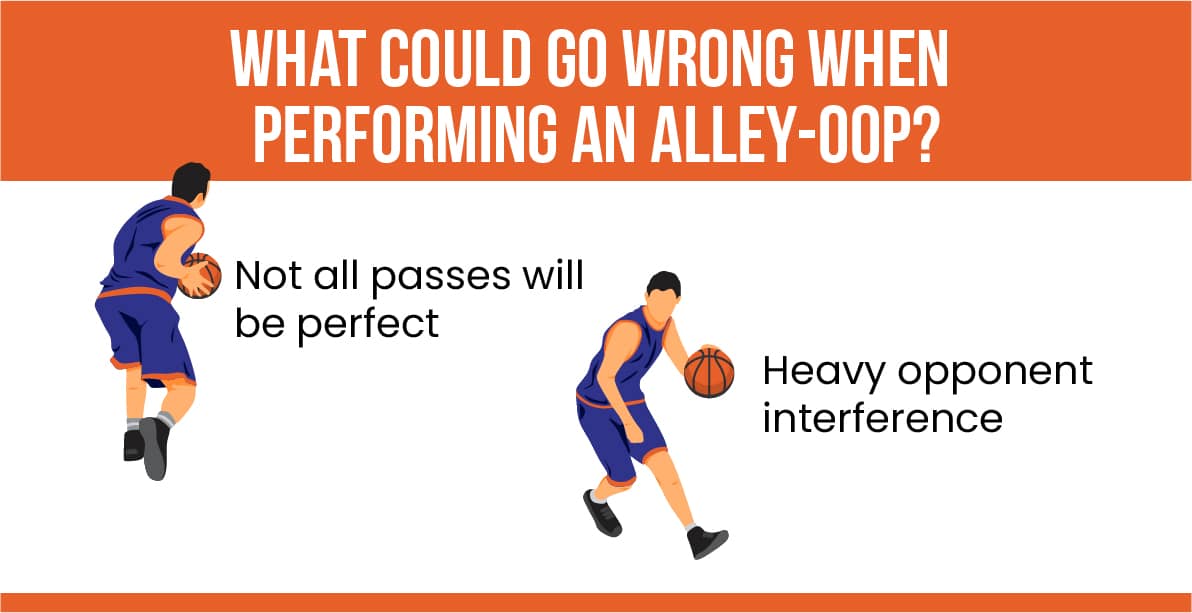
Not all of the passes completed by your teammate during an Alley-Oop Dunk are going to be perfect - many of them will actually be downright awful.
There is also the potential for heavy interference when trying to complete the Alley-Oop Dunk, so for the sake of ball security, dunking with two hands is the percentage play with the Alley-Oop.
We have seen, with many Alley-Oop Dunks, that the second player actually has to fetch the ball from below the rim of the hoop, lift it up to above head high and then complete the Slam Dunk. To pull the Alley-Oop off under those circumstances, without looking too silly you should probably opt to Dunk The Basketball With Two Hands.
The option to Dunk The Basketball With One Hand will most likely present itself if and when the player initiating the Alley-Oop play makes the pass hover just above the rim and directly on the path of the dunking player when he is airborne. Essentially when there isn’t too much of an adjustment to be made before completing the dunk.
How Do You Finish An Alley-Oop?
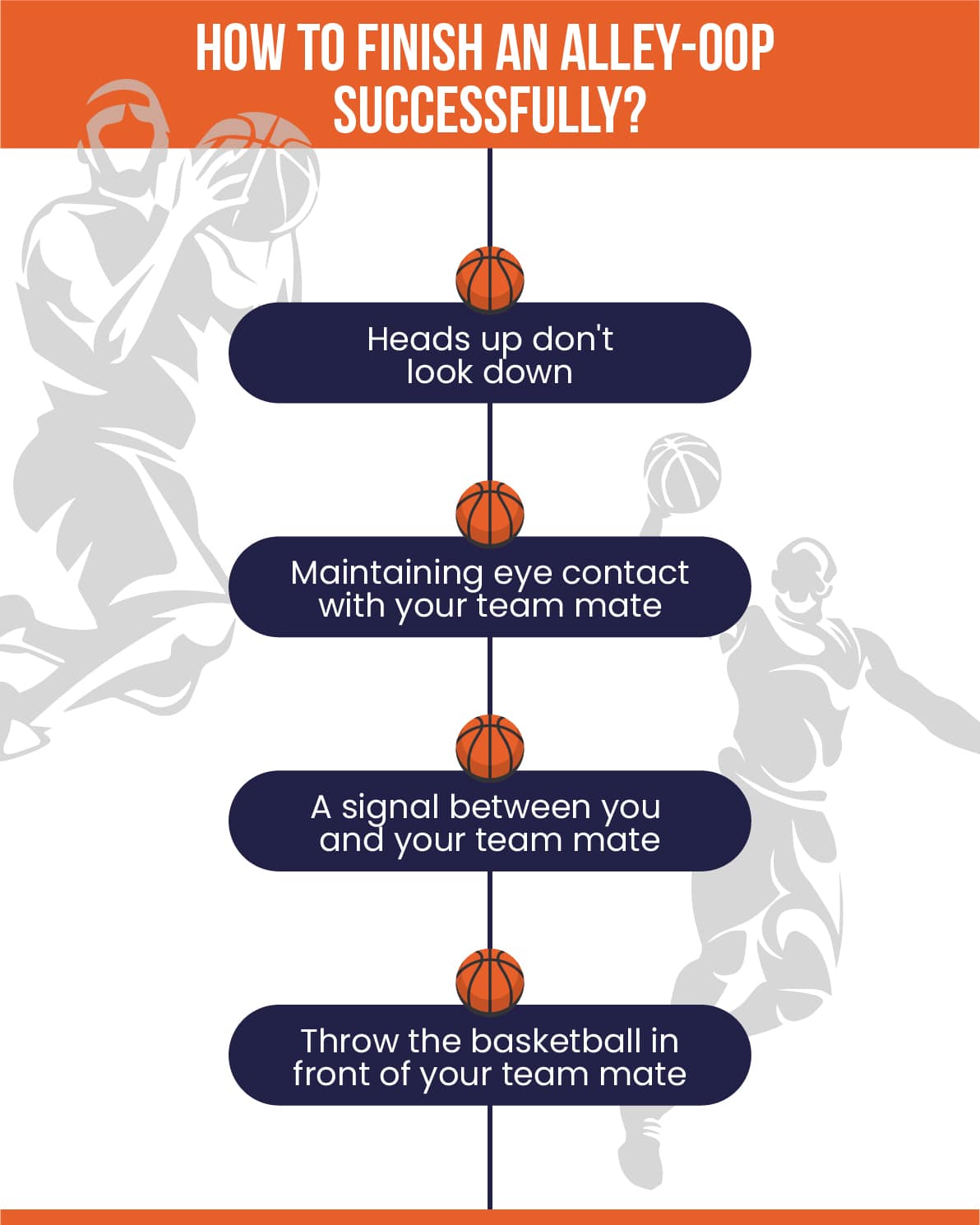
There are five Core Factors you need to carefully consider during the build-up and completion of the traditional Alley-Oop Dunk.
1- The player initiating the Alley-Oop Dunk will be dribbling towards the opposing team’s net. It is critical that while Dribbling The Basketball he does so with his head up and not while facing down.
Well, in all fairness this principle applies under all circumstances when you are dribbling on a basketball court. However, we emphasize it here with the Alley-Oop because there needs to be some form of communication between the two players before a decision is taken to make the Alley-Oop play.
There is normally a signal given by the player expecting to Dunk The Basketball and the dribbling player needs to be able to see that signal before making the pass. You are not going to pick up on that signal facing down! You are not a fish.
2- This is a progression from the first key moment in this play. While dribbling with your face up, you need to try and make eye contact with any of the potential dunkers in your team.
Having practised and played with them, it sometimes only ever takes a little eye contact to know that the time has come to “bring down the house”.
It is also important to make that eye contact so that you can better judge the movement of your teammate before making the critical pass for the Alley-Oop Dunk. Knowing and understanding the potential dunker’s movement helps you better judge the weight and the accuracy of the pass.
3- So, there will obviously be some form of signal between the two players executing the Alley-Oop Dunk but the last thing you want is to give the plan away to defending players.
The signal needs to be discreet and it needs to be subtle, otherwise defending players are going to snuff you out before you can say “dunk”. Far too many players are still prepared to point up when a decision is taken to try the Alley-Oop. That is a dead giveaway.
4- We have touched on this very briefly in this blog but it is important to know your teammates well. You need to know which players need to Jump Higher than others.
You need to know which players Dunk The Basketball well and which players are not suitable partners for the Alley-Oop Dunk altogether. Passing that ball to a guy who cannot really dunk is brainless.
There is no other way for us to phrase it!
So, be cerebral when you are on the basketball court. You need to know which players can catch a basketball with one hand and which players can catch the basketball with two hands.
You need to know which players can dunk the basketball with one hand and which players can dunk the basketball with two hands. Remember that the play which dictates the pass for the Alley-Oop dunk will not always be perfect. You need to know how and when to adjust accordingly.
5- When you throw a basketball for the Alley-Oop Dunk, you must never pass the ball directly at your teammate. That breaks momentum and minimises the prospects of completing the dunk.
Always throw the basketball in front of the approaching player and somewhere in the region of the rim, preferably well above it. Never wait until your teammate jumps, before throwing the Alley-Oop because that is simply too late.
Is It Easier To Dunk Off An Alley-Oop?
A compelling feature of the Alley-Oop Dunk is that it can be performed With One Hand Or With Two Hands. We will not categorically say that the Alley-Oop Dunk is easier than the conventional Slam Dunk just yet.
However, it does become immediately apparent to all and sundry that the Alley-Oop Dunk does not have favourites. That is to say that the Alley-Oop Dunk can be equally well executed by those who prefer to Dunk The Basketball With One Hand and those who prefer to Dunk The Basketball With Two Hands.
We have suggested that one of the determining factors for players wishing to Dunk A Basketball is personality. The more bullish players are most likely to dunk a basketball with one hand, while the more conservative players are most likely to dunk a basketball with two hands.
Regardless of how you dunk a basketball, the Alley-Oop should be an easy routine to pull off on a basketball, provided that you have some meaningful experience dunking a basketball.
However, if this is your first time at the rodeo, it would be remiss of us to encourage you.
The Alley-Oop Dunk remains a detailed basketball routine and does require a certain level of coordination from at least one player to be executed with some aplomb. With the Alley-Oop Dunk, not everything lies in your court! We have already mentioned how circumstances and conditions can change - and not be ideal for you.
How Do You Do A Self Alley-Oop?
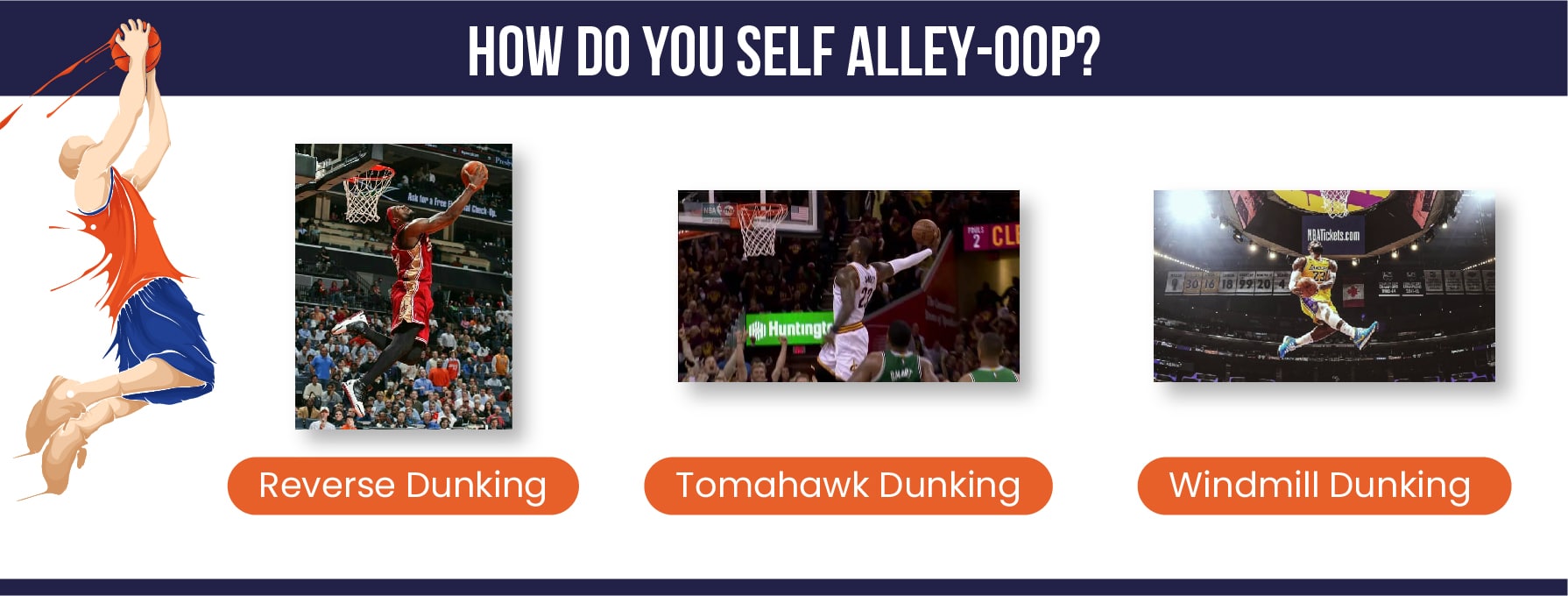
Throughout this piece, there has been tremendous emphasis on the Alley-Oop Dunk as a team play - because that is what it is. However, there is also an option (although not as common) to complete the Alley-Oop Dunk on your own.
The basketball skills level needs to be quite high to complete the Self Alley-Oop Dunk but is it by no means impossible to execute. Many people can actually execute it pretty well.
You will see many of these in basketball dunk contests and not so much in a match situations though. In fact, the author of this blog cannot actually recall seeing this being done in a basketball match.
Usually, the chap executing the Self Alley-Oop Dunk will take the basketball and throw it up in the air - which already seems like a considerable amount of unnecessary basketball admin - and then have that ball bounce somewhere within the vicinity of where the hoop is.
The ball does need to bounce high enough or in a range where he can then grab the basketball and subsequently complete the Slam Dunk. The real appeal with the Self Alley-Oop Dunk is that you can get rather adventurous with it and really entertain basketball fans - and that is honestly its only real purpose - through the method mentioned above anyway.
When completing the Self Alley-Oop Dunk, you have the option to execute a Reverse Dunk. (Those are always pretty to watch.)
In addition to that you can execute the Self Alley-Oop as a Windmill Dunk.
You can also execute the Tomahawk Dunk off the Self Alley-Oop.
While we do not really see the logic of the Self Alley-Oop in a match situation, it does come with its merits for basketball players who have short hands and constantly encounter some level of difficulty trying to palm the ball while trying to dunk.
The Self Alley-Oop provides them with a decent opportunity to ride the momentum of the basketball before completing the Slam Dunk.
If you are a Short Basketball Player or a Beginner, you do not want to catch the ball when it is below the rim before trying to complete the Self Alley-Oop.
Basketball players who fall within this bracket normally struggle with Jumping Higher On A Basketball Court too. So, when you execute the Self Alley-Oop you do not want to leave yourself with too much of a height deficit to make up for before dunking.
If you have to jump much higher than usual to execute the Self Alley-Oop you are already facing a hiding to nothing and are unlikely to come off feeling like a winner here. Ideally, you want that ball to be a little above the rim when preparing to complete the Self Alley-Oop.
As is the case with the more conventional Alley-Oop Dunk, timing matters a considerable amount here but the main difference this time is that the onus on getting that timing right is all on you.
There is no room to blame a teammate for misjudging the bounce or the speed of the basketball before completing the dunk.
The key here is to wait a short period after throwing the ball up for yourself. Once you notice that the trajectory of the basketball is starting to change - when the ball is starting to fall - that would be your cue to start running towards the ball, scooping it and then dunking it.
You do not want to catch that ball while it is still on the way up. It is not illegal but you will almost always struggle to complete the Self Alley-Oop Dunk under those circumstances.
There is also the option of executing the Self Alley-Oop by throwing the basketball towards the backboard, letting it bounce off the glass and then finishing off the dunk by yourself. That does qualify as a Self Alley-Oop too and actually happens more in the NBA than you think. Some of the best-looking Alley-Oops last season came off the backboard.
There is an element of surprise that comes with completing the move this way and it is also normally when an attacking player finds himself out of feasible options. In this context the Self Alley-Oop becomes somewhat of a get-out-of-jail-free card.
Conclusion
While the Alley-Oop Dunk is a glamorous basketball slam dunk, it does have some practical applications.
The capacity to pull it off can be useful when you are on the basketball court. The most fascinating thing about the Alley-Oop Dunk - and many people take this for granted - is that it requires all of the core basketball principles to be implemented well if you want to succeed.
The Alley-Oop Dunk is a routine that favours basketball players who can jump well, pass well, dictate play well and ultimately players who know how to dunk well - either with one hand or with two hands.
Hey, I’m Aleksandar and I am a Basketball freak! That is why I decided to create this blog. Teaching people How to dunk a basketball and How to Jump Higher in this sport or other related sports that require vertical jumping, is my specialty. If that’s your aim, then you have come to the right place.
